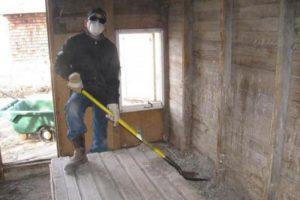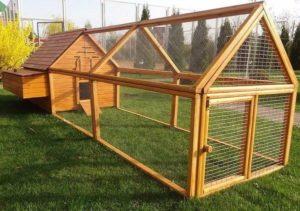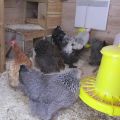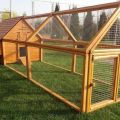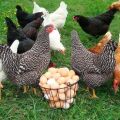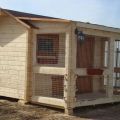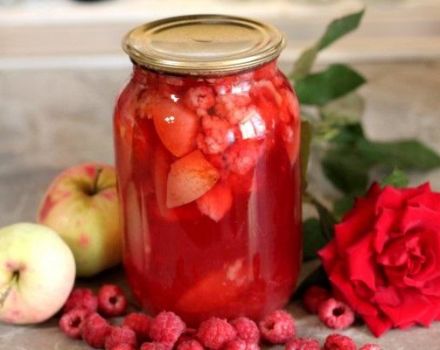Instructions on how to insulate a chicken coop for the winter with your own hands
With the advent of winter cold, egg production of chickens falls. This is due to a decrease in daylight hours and a drop in temperature. Having carried out simple work on warming the chicken coop, you can support the layers, create comfortable conditions for them, and thus provide family with eggs in the cold season. Consider what conditions are necessary for chickens for wintering, how to properly insulate a chicken coop.
Are chickens afraid of frost?
In winter, prices for eggs in stores rise steadily, as to maintain egg production, you have to spend money on lighting and keeping the hen coops warm. Although chickens are unpretentious, they can withstand a significant drop in temperature, they do not want to be carried in such conditions.

Features of the life of chickens at different temperatures:
- Chickens can live comfortably at a room temperature of at least 15 °.
- It is permissible to release chickens for walks at temperatures down to -10 ° for no more than 1-2 hours.
- Chickens rush without decreasing productivity at 23-25 °. If the temperature is lower, the number of eggs decreases. Below 15 °, the egg production of chickens drops noticeably. Chickens do not fly below 5 °.
The cost of obtaining eggs in winter increases significantly, many consider keeping hens in winter unreasonable. To have homemade eggs in cold weather, the chicken coop will have to be insulated for the winter.
Important: when preparing the chicken coop for winter, you will need insulation, disinfection of the room, provision of lighting and ventilation.
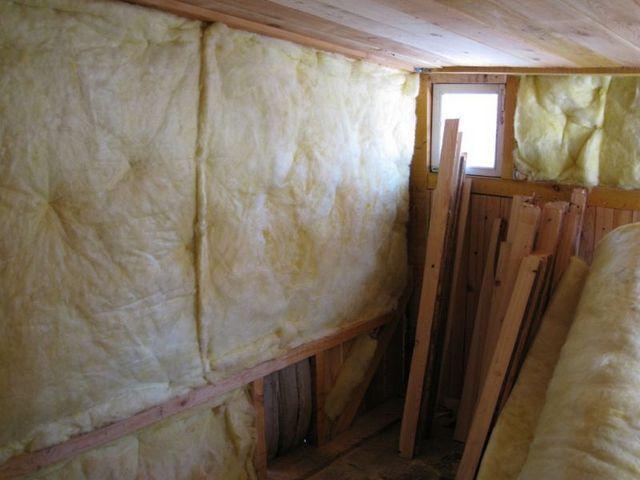
How to insulate the floor?
Cold air sinks down, so floor insulation in the chicken coop is the most important task. A thick layer of heat-insulating material will provide the chickens with a comfortable stay in the room. The cheapest and most effective way to keep your floor warm is with natural underlays. You should not feel sorry for the material - a thin layer will not cope with the task.
The layer should be 10-15 centimeters. Chickens will be happy, as they love to dig with their paws in the husk and earth.
Moss peat
Swamp moss peat perfectly absorbs moisture and droppings. The legs of chickens remain dry and healthy, less often fungal diseases and dermatitis develop. Peat absorbs the smell of chicken coops.
The use of peat protects against general unsanitary conditions indoors. After replacing the litter, the peat is preserved; it will also become an excellent fertilizer for the beds.

Straw
Straw is an excellent floor insulator. For chicken coops, it is combined with hay, which makes the layer soft and fragrant. Useful herbs will additionally protect chickens from infections.It is important to find clean, fresh straw and dry grass, without signs of rotting and high humidity.
It is recommended to lay a layer of 15-20 centimeters, regularly stir up the litter, add fresh straw when caking and chopping.

Shavings and sawdust
The material pleasant for chicken legs is wood shavings. They have a lot of useful properties:
- absorb moisture;
- flavor the room;
- shavings of coniferous trees emit essential oils - they disinfect chicken coops, protect layers from diseases.
The shavings are combined with sawdust in a ratio of 3 to 1. The litter in the chicken coop is regularly agitated, and a new layer is added when caking.

We insulate the walls
If the owners dream of receiving eggs all winter, they need to insulate the walls. Most chicken coops are built of wood, the thickness of the walls is usually determined by the characteristics of the climate of the region. Log and plank walls need insulation. The building is thermally insulated from the outside and inside, using different types of materials.
The most effective way to keep warm in a chicken coop is to build a lathing of beams and lay insulating material inside. In modern conditions, these are usually synthetic fillers - mineral wool, foam. You can use natural ones - straw, sawdust.
Hay and sawdust
Before laying in the walls, natural materials are thoroughly dried, mixed with slaked lime in a ratio of 1 part calcium hydroxide to 25 parts of an insulator.
A layer of vapor barrier is laid on the walls inside the chicken coop, the seams are fastened. Then the boards are laid tightly on top. Between the boards and the vapor barrier, the main material is poured - hay, sawdust, straw, dry foliage, coniferous needles. Tamp it tightly.

Minvata
For fastening mineral wool, a crate is installed with a distance between the bars less than the width of the material by 1-2 centimeters. A vapor barrier is placed on the wall, sheets of mineral wool are laid tightly end-to-end, and they are fixed to the wall. Another layer of vapor barrier is covered with mineral wool from above, it will retain moisture coming from the chicken coop.

Styrofoam
Fine lightweight, fine-mesh material that retains heat due to air bubbles inside the polymer. Available in convenient size sheets. Fastened to the wall of the chicken coop with plastic "mushrooms" with wide caps that do not destroy the plastic material. Use 2 mushrooms for each leaf.
On both sides of the foam, a vapor barrier is laid; the sheets can not be connected to each other.

Polyurethane foam
Lightweight polyurethane-based insulation material. It has low vapor permeability and high waterproofing properties. It is produced in the form of slabs, construction foam that hardens quickly.
To insulate the chicken coop, you can use any option - the plates are attached to the walls, the gap between the wall and the board crate is filled with foam.
Reference: any kind of finishing material is placed on top of the insulation and the lathing - non-corrugated slate, drywall, lining. The trim helps protect the insulation from chickens who like to peck at anything.

How to insulate windows and doors with your own hands?
Heat escapes from the hen house due to drafts, through poorly fitted doors and windows. In order not to freeze the chickens, before the cold snap, work is carried out to seal the cracks, restore the integrity of the door and window frames.
During construction, a double frame is provided for the window. The opening itself is best done on the south or east side to increase the flow of light. When cold weather sets in, a sheet of dense polyethylene is attached to the frame, filling the cracks with foam rubber or felt.
The door frame is insulated around the perimeter with a tape made of felt or dense fabric, the threshold is raised so that it does not blow on the floor. The door is upholstered on both sides with insulation - an old carpet, carpet, felt.
The main thing is not to overload the door, so that it does not lead in the frame.
Insulation of the ceiling and roof
So that the warm air rising up does not leak through the ceiling and roof of the chicken coop, they are carefully sealed with hydro and vapor barrier. Thermal insulation materials with a thickness of 5-15 centimeters are used.
Sequence of works for the roof:
- Waterproofing is laid under the roofing material. It is attached to the beams with a construction stapler, the joints are connected with tape.
- Lay insulation (mineral wool, polystyrene) so that the sheets do not fall out, pull the rope or twine between the rafters.
- Cover with a vapor barrier cloth, sealing the joints with tape.
- On top of the insulating protection, a decorative finish is laid - drywall, plywood.
The same materials are used to insulate the ceiling. To prevent the insulation from getting wet, put a vapor barrier film. If the attic is not used, you can use cheap bulk materials for insulation - sawdust, shavings. Most often, they put mineral wool or foam. The gaps are sealed with crumb and polyurethane glue.
A ventilation gap is left on top of the thermal insulation and boards, plywood sheets are laid on which you can walk or stack chicken feed, inventory.

Heating systems
Even in a warmed chicken coop, chickens will not be able to maintain the temperature required for egg production with their heat. In most regions, laying hens will delight with an abundance of eggs only in heated rooms.
If the chicken coop is located near the house where the family permanently lives, the most inexpensive and safe is to connect it to the house heating system. It is advisable to build a chicken coop near the house so as not to pull and insulate the pipes with water.
Consider which heating systems are advisable to use in chicken coops, how experienced amateur poultry houses heat their layers.
Potbelly stove or brick oven
The simplest and most affordable option is a brick oven or a potbelly stove. Heating requires a boiler or stove and chimney. Advantages:
- easy installation;
- simple inexpensive fuel;
- easy care.
A significant disadvantage of this type of heating is the almost open fire and, as a result, low fire safety. An accidental spark can quickly ignite the bedding of a chicken coop. In addition, the fuel has to be constantly tossed up, which is possible only for those who are at home most of the time and can watch the chickens.

Diesel stove
Diesel stoves for chicken coops are safer, have a temperature regulator, which allows you to keep the heat at the desired level. They are smokeless, do not poison the air with an unpleasant odor.
When choosing a diesel oven, a power calculation is required to ensure that the chicken coop is heated correctly. You must always have a supply of fuel. For many, the prices of diesel fuel are too high to operate diesel stoves.
The installation and purchase of a stove for heating chickens also requires significant costs.

Radiator
Radiators are a safe and convenient way to heat your chicken coop. Electric radiators do not require the constant presence of the owners, they supply a constant flow of heat, its intensity can be set with a regulator.
If necessary, put an additional device for heating chickens, radiators are mobile, they can be moved to the desired place.
The obvious drawback is the large electricity bills that many cannot afford. When installing radiators, it is necessary to take all the wires into special boxes, install reliable electrical outlets so that curious chickens do not damage the equipment and do not suffer themselves.

Infrared lamps
Using electrical appliances to heat your chicken coop, the easiest way to reduce costs is with infrared lamps. These devices do not heat the air, but directly the objects to which they are directed. Advantages of infrared lamps:
- ease of installation;
- complete safety;
- low energy consumption;
- positively affect the health of chickens, protect against infections;
- a large selection of types - stationary and mobile, panel, film.
With the help of lamps, it is convenient to heat individual places, directing them, for example, only at the chickens. Of the shortcomings, experienced poultry farmers note the high price, the need to have a constant supply, since the lamps often fail.
Many people keep chickens for the summer, but, getting used to the delicious eggs from their hens, they decide to keep the bird in the winter. Insulation of the chicken coop helps to provide chickens with a comfortable and safe existence in the cold season, and the owners - to eat healthy and tasty eggs all year round.

